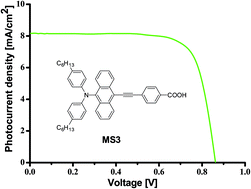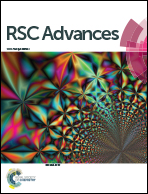Acetylene-bridged dyes with high open circuit potential for dye-sensitized solar cells†
Abstract
A series of simple metal-free organic dyes MS1–MS3 have been designed and synthesized, and their optical, electrochemical, and photovoltaic properties were investigated. The molecular structures are based on a push–pull framework with a triphenylamine, naphthyldiphenylamine, or anthracenyl diphenylamine as the donor connected to a carboxyphenyl acceptor via a C![[triple bond, length as m-dash]](https://www.rsc.org/images/entities/char_e002.gif) C bond. The speciality of this new dye design is to obtain higher device open-circuit potentials. The dye-sensitized solar cells using this new sensitizer in combination with I−/I3− exhibited exceptionally high VOC values of 810, 844, and 866 mV for MS1, MS2, and MS3, respectively. The absorption bands of the anthracene-bridged dye MS3 showed remarkable peak broadening and red shifts due to the strong electronic coupling between the donor and bridge facilitated by the C–C triple bond, significantly promoting the light-harvesting capability. The resulting devices of MS3 showed large IPCE values of 75–80% in the region 370–590 nm, giving JSC/mA cm−2 = 8.16, VOC/mV = 866, FF = 0.76, and η = 5.44% under standard AM 1.5G one sun irradiation.
C bond. The speciality of this new dye design is to obtain higher device open-circuit potentials. The dye-sensitized solar cells using this new sensitizer in combination with I−/I3− exhibited exceptionally high VOC values of 810, 844, and 866 mV for MS1, MS2, and MS3, respectively. The absorption bands of the anthracene-bridged dye MS3 showed remarkable peak broadening and red shifts due to the strong electronic coupling between the donor and bridge facilitated by the C–C triple bond, significantly promoting the light-harvesting capability. The resulting devices of MS3 showed large IPCE values of 75–80% in the region 370–590 nm, giving JSC/mA cm−2 = 8.16, VOC/mV = 866, FF = 0.76, and η = 5.44% under standard AM 1.5G one sun irradiation.


 Please wait while we load your content...
Please wait while we load your content...